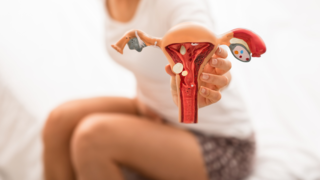In this article:
Remember, these marks are a natural part of pregnancy and a sign of the amazing work your body is doing to grow new life.
What Are Pregnancy Stretch Marks?
Stretch marks are visible lines that appear on your skin during pregnancy due to rapid stretching. As your body expands to accommodate your growing baby, the skin’s elastic fibres and collagen can weaken or tear, leading to these marks. They often show up in the last trimester when your belly reaches its maximum size, but they can appear earlier too. Stretch marks vary in colour and texture, starting as reddish or purplish lines and fading to a greyish-silver shade over time. They’re a natural response to your body’s changes and affect more than half of all pregnant individuals.Stretch marks typically form on your belly, hips, thighs, breasts, back, arms, and knees.
Myths and Facts About Stretch Marks
Many myths about pregnancy stretch marks circulate, often fuelled by marketing claims. Many of these claims sound convincing, but they’re not always true. In fact, a lot of the information out there is based on myths or unrealistic expectations. Take a look at the following to help you tell the difference between myths and facts.Myth 1: Stretch Marks Can Be Completely Prevented
You can’t fully prevent stretch marks because their formation depends on factors like genetics, skin elasticity, and hormonal changes. Some products claim to stop them, but no cream or oil can penetrate deeply enough to prevent the tearing of elastin and collagen.Myth 2: Only Overweight Individuals Get Stretch Marks
Stretch marks don’t discriminate based on weight. Over 90 per cent of pregnant individuals develop them, regardless of their body type. Weight gain during pregnancy contributes, but hormonal changes and skin stretching are the main reasons. Even people who maintain a healthy weight can get stretch marks, as it’s a natural part of pregnancy.Myth 3: Stretch Marks Spread to Other Body Parts
Stretch marks don’t spread like a disease. They form only where the skin stretches rapidly, such as your belly or thighs. They’re caused by local strain on elastin fibres, not by any contagious or spreading process. You don’t need to worry about them appearing on unrelated areas like your face or hands.Myth 4: Stretch Marks Disappear After Losing Pregnancy Weight
Losing weight after pregnancy won’t make stretch marks vanish. In fact, rapid weight loss can make them more noticeable by tightening the skin further. Stretch marks fade gradually over time with proper care, but they don’t disappear completely.Myth 5: Hormones and Genetics Don’t Affect Stretch Marks
Hormones and genetics play a significant role. Pregnancy hormones weaken collagen, making your skin more prone to stretch marks. If your mother, sister, or grandmother had stretch marks during pregnancy, you’re more likely to get them too. Accepting this hereditary link can help you manage expectations and avoid unnecessary stress.Myth 6: Stretch Marks Stay Forever
Stretch marks don’t last a lifetime in their initial form. After childbirth, they fade from reddish or purplish to a less noticeable greyish-silver. Their appearance can diminish further with regular care, such as hydration and exercise. They may not disappear entirely, but they become much less prominent over time.Myth 7: Expensive Creams or Cocoa Butter Prevent Stretch Marks
High-priced creams, including cocoa butter, don’t prevent stretch marks. These products are great for moisturising, but they can’t stop the underlying tearing of skin fibres. Overusing creams during pregnancy might even cause rashes. Focus on hydration and a balanced diet instead of relying on costly products.Myth 8: Using Toner Reduces Stretch Marks
Toners tighten the skin, which can worsen stretch marks by increasing tension on already stretched areas. Instead, use moisturising lotions to keep your skin hydrated and supple. This may help reduce the visibility of stretch marks over time.Myth 9: Stretch Marks Are a Sign of Poor Health
Stretch marks are a normal part of pregnancy and not a sign of unhealthy habits. They reflect your body’s adaptation to rapid growth, not your overall health. They’re common across all body types and don’t indicate any medical issue.Myth 10: Only First-Time Parents Get Stretch Marks
Stretch marks can appear in any pregnancy, whether it’s your first or fifth. Factors like multiple pregnancies, corticosteroid use, or younger maternal age can increase the chances, but no pregnancy is immune. Each pregnancy brings unique changes to your skin.Myth 11: Stretch Marks Are Always Itchy
Not all stretch marks itch. Some individuals experience itching as the skin stretches, but others don’t. If you do feel discomfort, gentle moisturising and avoiding harsh products can help soothe your skin.Myth 12: Nothing Can Be Done to Treat Stretch Marks
While prevention is tough, treatments can reduce the appearance of stretch marks. Options like laser therapy can improve skin texture and tone. Always consult a dermatologist to find the best treatment for you.Prevention Strategies for Stretch Marks
You can’t stop stretch marks entirely, but certain habits can help minimise their appearance. These lifestyle changes support your skin’s elasticity and overall health during pregnancy:- Drink plenty of water to keep your skin supple and elastic, which may reduce the chances of severe stretch marks.
- Eat foods rich in vitamins C and E, zinc, and collagen-building nutrients to support skin health and repair.
- Regularly massaging your belly, hips, and thighs improves blood flow and collagen production, helping maintain skin elasticity.
- High stress levels may lead to changes in hormone levels that affect skin elasticity. Practice relaxation techniques like yoga or meditation.
- Use moisturising lotions to nourish your skin. Avoid toners or harsh products that could tighten or irritate stretched areas.
Treatment Options for Stretch Marks
You may want to explore treatments to reduce the appearance of stretch marks after pregnancy. Professional options can improve skin texture, but always seek advice from a dermatologist or specialist.- Laser therapy: This uses advanced technology to target stretch marks. It improves skin tone and reduces their visibility.
- Microdermabrasion: A gentle exfoliation technique that refines skin texture, making stretch marks less noticeable.
- Chemical peels: These treatments remove outer skin layers and promote new skin growth, fading stretch marks.
- Topical creams: Dermatologist-recommended creams can hydrate and revitalise skin, though they work best alongside other treatments.
Embrace Your Body’s Changes
Stretch marks are a natural part of pregnancy, and they tell a powerful story of your body’s strength. Accepting these changes can support a positive body image during and after pregnancy. You don’t need to hide them or feel ashamed. Instead, it helps to view them as part of your unique experience. Think of them as battle scars from the incredible journey of bringing life into the world.Pregnancy stretch marks are a natural part of your journey to parenthood. They’re not flaws but reminders of what you’ve achieved. You can’t fully prevent stretch marks, but a healthy lifestyle and proper skincare can lessen their severity.
FAQs on Pregnancy Stretch Marks: Myths and Facts
- What causes stretch marks during pregnancy?
Stretch marks occur when your skin stretches quickly to make space for your growing baby. This causes tiny tears in the skin’s middle layer, especially when hormones weaken collagen and elastin. - Can I completely prevent stretch marks?
No. You can reduce their appearance with hydration, good nutrition, and moisturising, but you can’t fully prevent them. - Do stretch marks go away after giving birth?
They don’t go away completely, but they fade over time. They usually change from red or purple to a silvery-grey shade and become less noticeable.






